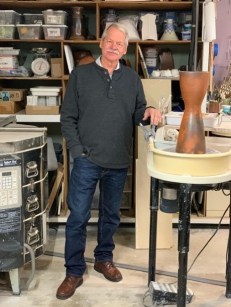Abby Leon, Paradigm Gallery Director
The FWMoA team works endlessly to bring you new artwork to enjoy throughout the museum during each of your visits! In our most current display, you can view artist George Morrison’s sculptures in both FIRED UP: New Vistas in Ceramics and the Paradigm Gallery. In this recent series, Morrison explores his version of an urban landscape. After 35 years in the industry, Morrison’s accomplished architectural background is consistently rooted in his art, shaping the distinct characteristics he is known for. Read on to learn more about why and how he creates from the talented sculptor himself!
My interest in clay may have been inspired by summers in my youth working as an apprentice bricklayer for my father’s masonry construction company. After all, a brick building is essentially ceramic. Another influence is the philosophy of the architect Louis Kahn (a master in the use of brick) who taught that each building material should be used as an unadorned expression of its own unique qualities and characteristics.
Clay is a vehicle for the exploration of form, pattern, volume, and space, all very architectural characteristics. I often use molded, extruded, thrown, and slab formed elements as architectural building blocks.
My process involves the experimental manipulation of clay in a search for the unexpected. I enjoy the challenge of finding the most unique forms from the least number of steps: what happens if I extrude a simple triangular clay form and then drop a bowling ball on it? What do I get by taking a single wire-tool slice through a long, rectangular, extruded “brick” form? This spontaneity is made permanent in the finished ceramic piece.
When these manipulations do not yield aesthetic results, I’m willing to abandon the initial vision and let the clay lead me in new and unanticipated directions. This allows a dialogue to take place between my goals and the inherent properties and “nature” of clay as it adheres to the laws of physics.
A title is selected after the piece is in its final form based on my reaction to it. Song titles or other musical references are often sources. Humor might be used to discourage taking the work too seriously.
Whether functional or non-functional, my hope is that my work will be a truthful representation of the unique ability of clay to become a stationary document of how it was manipulated in its fluid state.
There are several time-consuming stages of work required to produce ceramic art. Each stage is an opportunity for excellent results. Unfortunately, each stage is also an opportunity for flaws and failures that often don’t become apparent until the final firing: cracks, glaze flaws, warping, and more. Ceramic artists, therefore, tend to develop repeatable tried-and-true processes that ensure a higher level of success. This becomes the recognizable blueprint for their work. The blueprint for my recent work focuses on the challenge of making strong visual statements while expediting the forming of each piece, allowing me to produce many pieces from which to choose for further development.
Below is a summary of some of my favorite processes, with pictorial examples.
FORMING
Most successful are those pieces extruded or slip-cast (molded) in replicable shapes. I enjoy building from mass produced units. These shapes are then minimally manipulated into visually impactful forms. Their rapid formation allows many experiments to take place in a short time. A good example is High Rise, a pair of triangular extrusions deformed by the simple act of dropping a bowling ball on the soft clay. Another example is the Urban Landscape, extrusions sliced in half with a single swipe of a wire tool. These pieces are straightforward expressions of the fundamental characteristics of clay.





SURFACING
Surfaces can be glazed, terra sigillata, or paint.
FIRING
In its final, dry form the work is bisque fired in an electric kiln. As an alternative to glazing and glaze firing, the work is sprayed with terra sigillata* before the bisque firing. The final firing is completed in a barrel of sawdust. This low-fire process can take more than 24 hours as the sawdust slowly smolders. Variations in temperature and airflow through the barrel leave smoky patterns and color on the surface.



You can see all of George’s featured examples (and more!) in person now! FIRED UP: New Vistas in Ceramics ends on January 29th. This show also highlights the work of artists Seth Green, Joseph Pelka, Joel Pisowicz, and Justin Rothshank. All the artwork is available for purchase through the Paradigm Gallery, open Tuesday-Saturday 10am-6pm; Thursday 10am-8pm; Sunday 12pm-5pm
*Terra sigillata is a contemporary interpretation of a process used to produce glossy red pottery in ancient Rome. Very fine clay powder is suspended in water through a process of deflocculation (The dispersion of an aggregate to form a stable colloid). This liquid is applied to the bone-dry clay surface and lightly buffed before the low temperature final sawdust firing.



